Coir coconut fiber is a natural cellulose fiber which is obtained from coconut husk. It is the fibrous material that is found between the outer coat of a coconut and the hard internal shell. Copra is the dried coconut kernels from which coconut oil is obtained. Coir coconut fiber comes from a natural and renewable source and is one of the latest eco-friendly alternatives for textiles.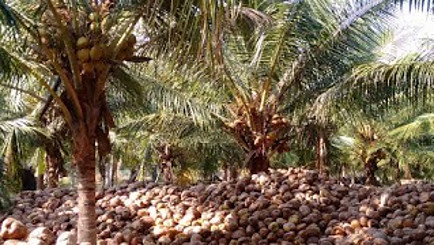 Coconut farming usually focuses on coconut oil, milk and water and other coconut products like desiccated coconut. Normally the coconut huskis discarded as waste, but it could be used.
Coconut farming usually focuses on coconut oil, milk and water and other coconut products like desiccated coconut. Normally the coconut huskis discarded as waste, but it could be used.
By using coconut husk, which is a bi-product of coconut farming, a waste product can be converted into eco-friendly and sustainable products.
Coconut Cultivation
Coconut palm trees grow in many coastal tropical areas of Central America, Asia, Oceania and Africa. It has been cultivated for more than four thousand years. The three top producers are Indonesia, Philippines and India and together they account for around 89 percent of world production.
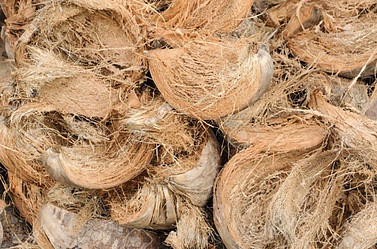 Coconut palms flower monthly and each fruit takes a year to ripen. Harvesting is done on an ongoing basis with each tree annually yielding 50 to 100 fruits.
Coconut palms flower monthly and each fruit takes a year to ripen. Harvesting is done on an ongoing basis with each tree annually yielding 50 to 100 fruits.
Coconuts are primarily a food crop but also provide fiber, fuel and building material. The coconuts that we generally see and buy, are the seeds of the fruit of the coconut palm tree.
There is an external leathery skin and a thick (5 to 8 cm) intermediate layer of fibrous pulp that surrounds the seed. The fiber that is obtained from the pulp is called coir. Depending on the thickness of the husks, each coconut or copra yields 80 to 150 grams of husk fibers.
Coir Coconut Fiber Production
Coir coconut fiber is obtained from the husks through conventional retting or mechanical and biological means. Retting is the action of micro-organisms and moisture to dissolve or rot cellulose tissues and pectin away from bast-fiber bundles.
- Conventional process: to soften the fibers, the husks are retted in brackish water for three to six months or in saltwater for ten to twelve months. During retting micro-organisms break down the plant tissues around the fibers to loosen them. The fibers are separated through decortication and beating and then hackled and washed. These produce the best quality fibers.
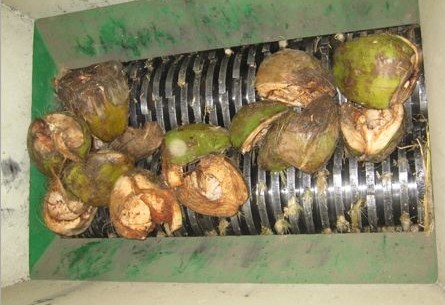
- A mechanical process has been developed to decorticate or defribillate the husks, but the quality is not as good as conventional retting. Through the mechanical process, retting can be shortened or even eliminated. Ripe husks can be processed in a crushing or shredding machine after only seven to ten days of retting. Immature husks can be dry milled without retting but produces only short fibers.
- A biological means of retting through enzymatic processes have also been developed, whereby enzymes are used to separate the fibers. The process is cleaner and milder than the mechanical process and can be done without any water pollution. It produces a better quality fiber than through mechanical processes.
Traditionally the retted pulp is beaten with a wooden mullet to separate the fibers from the pith and outer shell. In recent years the fibers are separated either by hand, or in a rotating drum that has spikes on the inside.
Fiber categories
Coir coconut fibers are either white or brown, depending on the age or maturation of coconuts on harvesting. 
- White fibers come from immature or green coconuts which are harvested after six to twelve months on the plant. These fibers are weaker than brown fibers, but smoother and finer. White fibers can be spun into yarn which can be woven into mats or twisted into rope or twine.
- Green coconuts are retted in seawater or artificially salinated water.
- Brown fibers are obtained from fully ripened and mature coconuts. The coconuts are harvested when the nutritious layer around the seed is ready to be processed into copra and desiccated coconut. It produces coarse but strong fibers and the fibers have a high abrasion resistance. Ripe coconuts are retted in fresh water.
Fibers from both brown and white coir range in length from ten to thirty centimeters. Long fibers that are at least twenty centimeters long, are called bristle fiber and the shorter fibers are called mattress fiber. About a third of the coir coconut fiber that each coconut will yield, is bristle fiber. Shorter fibers have a finer texture and is normally spun into yarn.
Coir pith is the residue that is left behind after the fibers have been extracted.
Eco-friendly Innovations With Coir Coconut Fiber
1. Coir Textiles
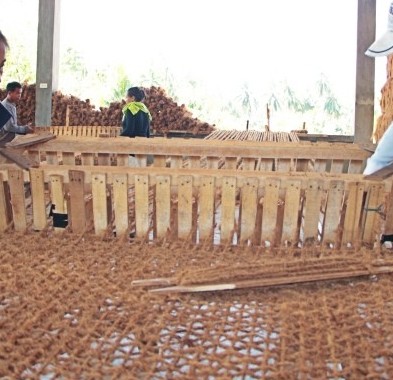
“Cocona” fabric is a textile that has been created from recycled coconut shells. Activated carbon is taken from the coconut shells and added to fibers, yarns and fabrics. The result is clothing that dries quickly, stays cool, absorbs odors and provides UV protection. It makes Cocona fabric ideal for sports wear.
By replacing synthetic polyester fibers with coconut husk fibers, consumption of petroleum will be reduced by two to four million barrels per year and carbon emissions by 450,000 tons per annum.
2. Coir Building Boards
A method has been developed in the Philippines to use the fibrous husk of coconuts to produce high quality building boards called “Ecocoboards”. Eco-friendly technology is used and no chemical adhesives are added. Panels and boards can be used for building and furniture applications and can be substituted for wood.
The Philippines has a shortage of wood so the use of Ecocoboards will reduce the amount of wood that has to be imported. The commercial use of coconut husks would increase the profitability of coconut farming and contribute to the export and economy of the Philippines.
Benefits of Coir Coconut Fiber:
- Coir coconut fiber is eco-friendly and bio-degradable. It comes from a renewable source and the fibers or fabrics are 100% bio-degradable.
- It is hard wearing and durable. Coir coconut fiber is water resistant and is the only fiber that is resistant to saltwater damage.
- Coconut husk fibers have a quick drying time. It absorbs moisture 50% faster than polyester.
- It eliminates odors – coir coconut fiber naturally absorbs odors and can minimize bad smells without additional treatments and chemicals.
- Coir coconut fibers absorbs harmful ultraviolet rays even after several washes, so provides UV protection.
- It is very strong.
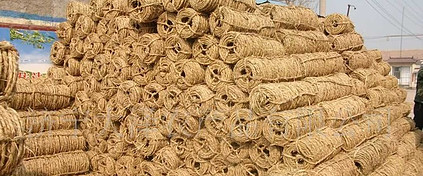
Disadvantages of Coir Coconut Fiber
There is concern about the amount of water that is used in retting and extracting coir coconut fiber from the husks. Traditional retting generates water pollution with many organic pollutants left behind in the water. These include pectin, tannin, fat, pectosan, toxic polyphenols and several types of bacteria including salmonella.
Scientists are experimenting with treatment options to reduce the amount of water pollution. Some manufacturers are claiming that they are treating the effluent water. Biological retting is a cleaner process and doesn’t pollute the water.
Uses of Coir Coconut Fiber:
There are many versatile uses for coir in products like brushes, mattresses, upholstery padding, doormats and floor mats, rope, sacks, insulation, tiles, fishing nets and many more. 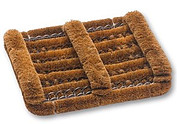
Coir coconut fiber makes perfect nets for harvesting shellfish and ropes for marine applications as it will not be damaged by seawater. 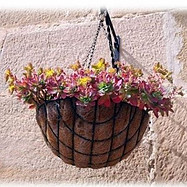
Coir is used in horticulture as a soil less growing medium and is an alternative to peat moss and vermiculite. It is used in hydroponics and make perfect linings for hanging baskets. Coir bricks or chips will add drainage and absorbency to potting soil and will absorb up to ten times it’s weight in water.
Coconut biomass has the potential to be used to generate energy. A new coconut power plant in Thailand has been designed specifically for the combustion of all forms of coconut waste and also conventional biomass.
The Future
As technology improves and production increases, new uses for coir coconut fiber are found and promoted. Coir is becoming a popular choice for making geotextiles. Geotextiles are permeable fabrics which when used in conjunction with soil, have the ability to filter, separate, protect, reinforce or drain. As more people turn away from non-biodegradable synthetics, use of natural fibers and geotextiles will increase.
If you have any questions or suggestions, please leave your comments below and I will get back to you.

I’m grateful for the opportunity to read this fascinating blog, thank you for sharing it. Your posts are truly enjoyable to read and waiting for your next post.
Lay flat grow bags are a type of container used for growing plants, herbs, vegetables, and fruits.
Thank you for sharing your knowledge on coir grow bags, which seems the perfect medium for growing fruits, flowers and vegetables. All the best.
My daughter bought me a house plant. It has a large bulb with small limbs that look like pine needles. It has no name but it says if you replant to use a special soil. It is grown by Costa Farms. Is it a coconut tree? What type of special soil do I use to repot this plant? Have never seen this house plant before. What is it?
Thank you for answering my question.
Elsie
Hi Elsie, I am sorry but I am not a horticulturist and without a photo of what your plant looks like, I cannot tell you if it is a coconut tree or not. If it was grown by Costa Farms, I suggest you go back to them, or the nursery where your daughter bought the plant, and ask them to identify the plant. They can also advise you on the soil required for repotting. All the best, Liné
Hey there,great article.Very informative. I’m so happy I chanced on it.Could you please zoom more into how activated carbon is extracted from coconut and added to fabrics?
Thank you
Thank you for reaching out. You might find this article on how is activated charcoal extracted from coconut shell helpful. All the best.
i would like to make a paper presentation on coconut husk textile to be used as clothing. is there any area that i should pursue to have additional innovation? or what other aspects of coconut husk textile should i focus on to have a contribution on this topic?
Thank you for reaching out. I would like to suggest that you look at geotextiles to see how coconut fiber can be included in textile production. All the best, Liné
What machine or process is used to make coconut material to make bags from? I have one that was made in India and I would like to know what machine has been used please. I have photos.
Your coconut bag sounds very interesting. Different manufacturers use different machines, so to find out which machine was used to make your bag, it is best to contact the manufacturer and ask them. It hope this helps.
Nice Article ??? ??
You are welcome and thank you
Thank you for sharing this article. It is educating and I must admit that I have gotten a great deal of knowledge regarding coir. How amazing it is that stuffs that look useless end up becoming very useful, as in the case of the coir. Coconut is one of my favorite fruits and I also love coconut oil. Coir has so many uses and application and this is absolutely incredible for me initially.
Hi there, Coconut is indeed a very versatile fruit and is also extremely healthy to eat. To use coir in products is far better than synthetic fibers.
I know that finding a good article does not come by so easily so i must commend your effort in creating such a beautiful website and writing an article to help others with useful information like this,who did imagined that coconut husk would have lots of benefits such as these,wow!Coconuts naturally possess a compound that encourages the development of beneficial bacteria, known as lignin. Coconut husk can also be used as bio fuel which is a source of charcoal. When processed, coconut husks can be used to produce various house hold products such as carpets and others.you’re the man.thanks and keep it up
Hi Wilson, Coconut and coir indeed have many application and are far better for the envirnment than chemicals and man-made synthetic products.
Hello there thanks for this review it was really helpful. There’s no waste product in coconut and it is interesting to know coconut husks can be this useful. Sincerely speaking I have seen most of these fiber materials but who would have thought that they were actually made from coconut husk. I must commend you for this article
Hi there, Coconut is very versatile and it is good that we not only use it as a source of food, but also use the husks for many applications. Coir is far more beneficial than any petroleum based products.
Hello Cowley! My mom uses this coir to make coconut fiber pots and also ground down to really fine particles to use them in our garden as it improves water holding capacity which acts as sponge to hold water in the root zone so that the plants can use it when they need it.
Coir is very useful in my house.
Hi there, What a great idea to ground down the coconut husk and use it in the ground to improve the water retention. Coir is great for lining hanging baskets and pots, as well as many other applications. It certainly sounds as if you are making full use of coconuts and what they provide us with.
Hi there! this is an amazing review you have got here. I totally agree with everything you have said here especially the usefulness of coir in textiles as it can be used for fishing nets, thanks to its resistance to salt water which makes it super cool for the fisher men.
However, I prefer the brown coir to the white one as its stronger.
Hi there, Coir indeed has numerous beneficial applications and both the white and the brown have their place and uses. To use coir for fishing nets are a thousand times better than nylon, or other plastic.
Hey nice article you have there. I so much love your site , as it always encourage maximization of natural resources. I must say I am just hearing about the Coir coconut fiber for the first time, it’s indeed an interesting fact about the coconut. I have learnt a whole lot from your site and this article precisely, thanks for that, keep the good work, Regards.
Hi there, Thank you for your kind comments and I do enjoy writing and researching what is available in nature and how we can utilise those, rather than petroleum based products.
this is serious, in most countries the coconut husk are not even considered to be useful, I noticed that most people who cultivate coconut only extract the water/and the edible skin (fruit). This review has greatly reveal how big the coconut faming can boost an economy and also lead to a sustable eco friendly society.
Petroleum product has been the major source of inflation and if it can be replaced according to this review, the price of things will drastically go down. Also the effect of carbon into the environment will be easily controlled.
Thanks for sharing such an educative information.
Hi there, I am not so sure about prices going down drastically, but if we can utilse what mother nature has given us in a more efficient way, it can lead to a lower carbon footprint being left behind.
This is such a fascinating article that helps us to learn even more about reducing unnecessary waste, so hearing that we can utilise the coconut even more is something I find really interesting. I would never have known that you could do so much with the husk if I had not have read your article.
I will be ensuring I look in to this further for my future purchases.
Thank you for taking the time to share this invaluable information.
Hi Emma, Coconut is indeed a very versatile plant. From using the fibers to the food products like coconut milk and oil, there are heaps of things we can do with coconuts and the husks. And even better that it is a natural product.
I really like your page. It seems like you really put a lot of effort into the style and the articles themselves are full of imagery and research. The color scheme is great and I myself am a lover of Coconut! Nature provides us with so many gifts. I have written some articles on super-foods myself. There’s a lot more to many of these foods like Coconuts than just eating or drinking from them! I like that you’re presenting us with creative ideas that help us sustain and make the most of the environment around us! Thank you!
Hi There, thank you for your kind comments. It is so true that nature provides us with an abundance of natural products and we need to make the best use of it while also looking after mother earth.
I knew coconut fiber could be used to make clothes, however until I saw the picture of the flower basket, I have the exact same one at home and I’ve always thought it was vines or some kind of wood, and door mats as well, a lot of these things I’ve been using but had no idea it was coconut. Thanks a lot for the information, would like to hear from you in the future more about coconut husk products. Cheers!
Hi Laureen, there are ongoing developments and coir coconut fiber is being used in reinforced concrete now as well.
Hi Lin, I just wanna ask if coconut coir can be a potential material in creating biodegradable face masks?
Hi Ela, I have not done any research or testing on using coconut coir in facemasks, so unfortunately cannot advise you. I suggest you contact a research institute. All the best. Liné